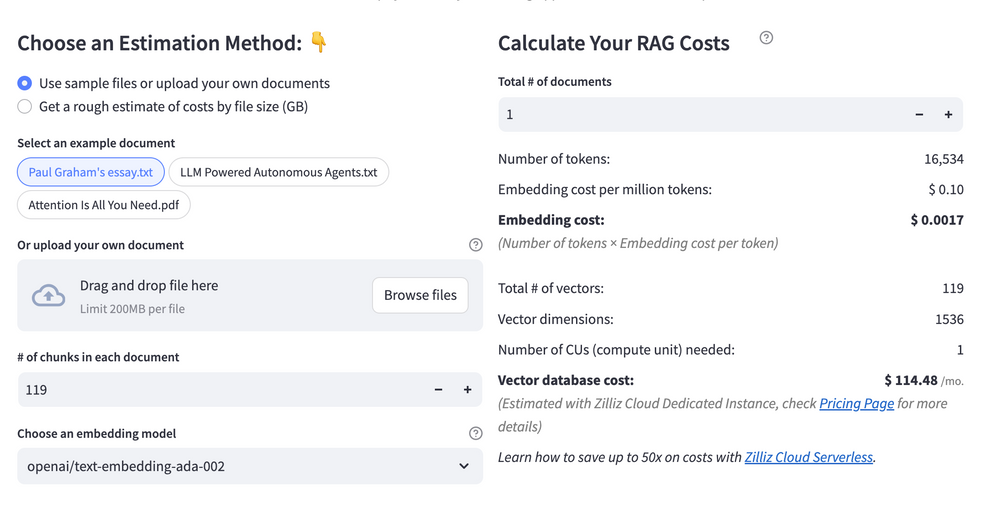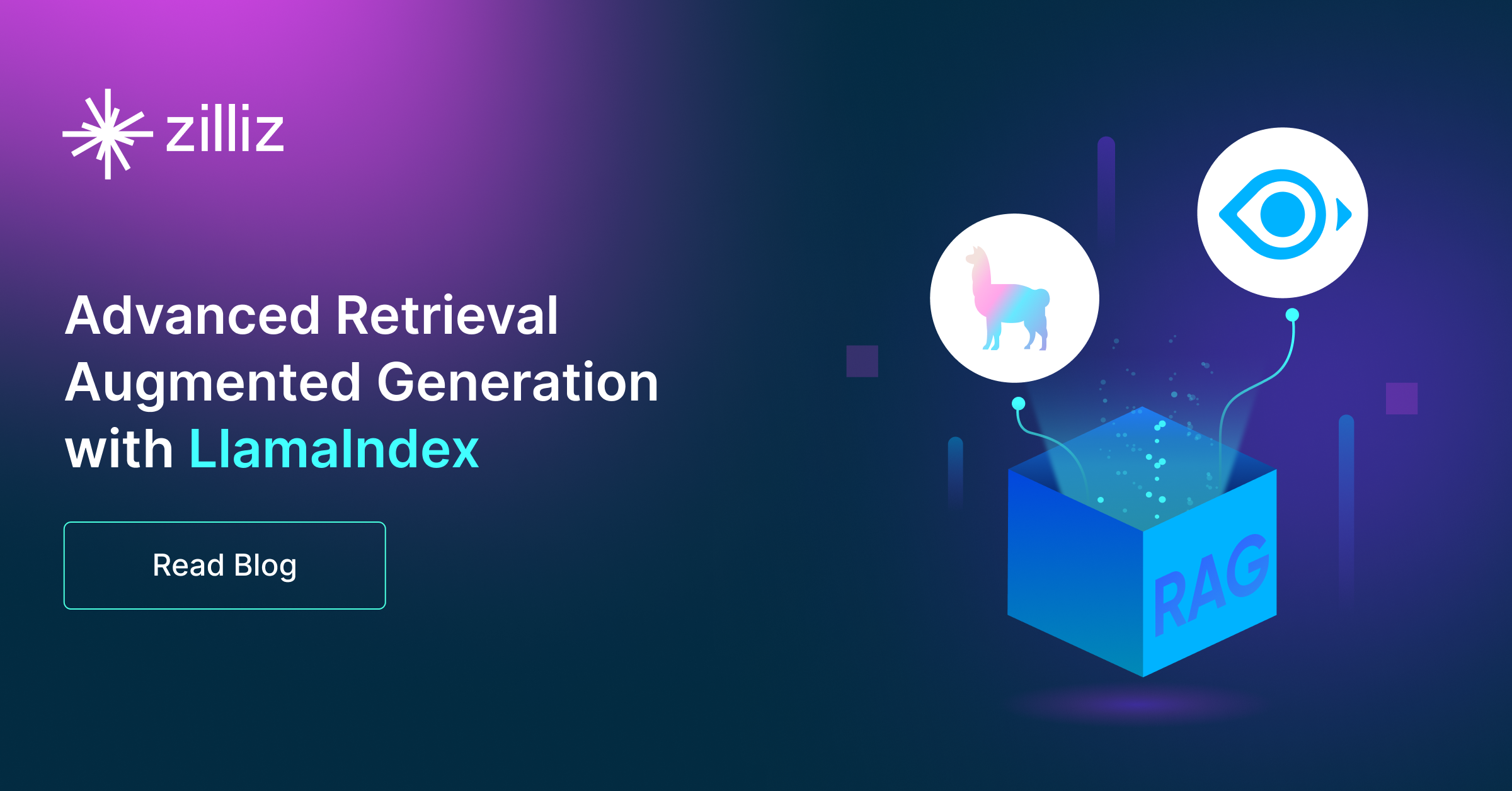Build RAG Chatbot with Haystack, Pgvector, Amazon Bedrock Claude 3 Sonnet, and OpenAI text-embedding-3-small
Introduction to RAG
Retrieval-Augmented Generation (RAG) is a game-changer for GenAI applications, especially in conversational AI. It combines the power of pre-trained large language models (LLMs) like OpenAI’s GPT with external knowledge sources stored in vector databases such as Milvus and Zilliz Cloud, allowing for more accurate, contextually relevant, and up-to-date response generation. A RAG pipeline usually consists of four basic components: a vector database, an embedding model, an LLM, and a framework.
Key Components We'll Use for This RAG Chatbot
This tutorial shows you how to build a simple RAG chatbot in Python using the following components:
- Haystack: An open-source Python framework designed for building production-ready NLP applications, particularly question answering and semantic search systems. Haystack excels at retrieving information from large document collections through its modular architecture that combines retrieval and reader components. Ideal for developers creating search applications, chatbots, and knowledge management systems that require efficient document processing and accurate information extraction from unstructured text.
- Pgvector: an open-source extension for PostgreSQL that enables efficient storage and querying of high-dimensional vector data, essential for machine learning and AI applications. Designed to handle embeddings, it supports fast approximate nearest neighbor (ANN) searches using algorithms like HNSW and IVFFlat. Since it is just a vector search add-on to traditional search rather than a purpose-built vector database, it lacks scalability and availability and many other advanced features required by enterprise-level applications. Therefore, if you prefer a much more scalable solution or hate to manage your own infrastructure, we recommend using Zilliz Cloud, which is a fully managed vector database service built on the open-source Milvus and offers a free tier supporting up to 1 million vectors.)
- AmazonBedrock Claude 3 Sonnet: A versatile AI model optimized for enterprise workloads, balancing speed and intelligence. Excels in high-accuracy reasoning, multilingual support, and cost-efficiency. Ideal for data analysis, content generation, retrieval-augmented generation (RAG), workflow automation, and multilingual applications. Seamlessly integrates with AWS services for scalable, secure AI solutions.
- OpenAI text-embedding-3-small: Designed to generate dense vector representations of text, this model excels in efficiency and cost-effectiveness, optimized for speed and low resource usage. It delivers competitive performance in semantic similarity, retrieval, and clustering tasks, making it ideal for large-scale applications like search engines, recommendation systems, and text classification where balancing accuracy with computational cost is crucial.
By the end of this tutorial, you’ll have a functional chatbot capable of answering questions based on a custom knowledge base.
Note: Since we may use proprietary models in our tutorials, make sure you have the required API key beforehand.
Step 1: Install and Set Up Haystack
import os
import requests
from haystack import Pipeline
from haystack.components.converters import MarkdownToDocument
from haystack.components.preprocessors import DocumentSplitter
from haystack.components.writers import DocumentWriter
Step 2: Install and Set Up Amazon Bedrock Claude 3 Sonnet
Amazon Bedrock is a fully managed service that makes high-performing foundation models from leading AI startups and Amazon available through a unified API. You can choose from various foundation models to find the one best suited for your use case.
To use LLMs on Amazon Bedrock for text generation together with Haystack, you need to initialize an AmazonBedrockGenerator with the model name, the AWS credentials (AWS_ACCESS_KEY_ID, AWS_SECRET_ACCESS_KEY, AWS_DEFAULT_REGION) should be set as environment variables, be configured as described above or passed as Secret arguments. Note, make sure the region you set supports Amazon Bedrock.
Now, let's start installing and setting up models with Amazon Bedrock.
pip install amazon-bedrock-haystack
from haystack_integrations.components.generators.amazon_bedrock import AmazonBedrockGenerator
aws_access_key_id="..."
aws_secret_access_key="..."
aws_region_name="eu-central-1"
generator = AmazonBedrockGenerator(model="anthropic.claude-3-sonnet-20240229-v1:0")
Step 3: Install and Set Up OpenAI text-embedding-3-small
Text documents often come with a set of metadata. If they are distinctive and semantically meaningful, you can embed them along with the text of the document to improve retrieval.
from haystack import Document
from haystack.components.embedders import OpenAIDocumentEmbedder
doc = Document(content="some text",meta={"title": "relevant title", "page number": 18})
document_embedder = OpenAIDocumentEmbedder(meta_fields_to_embed=["title"])
docs_w_embeddings = embedder.run(documents=[doc])["documents"]
Now let's install and set up the model.
from haystack import Document
from haystack.components.embedders import OpenAIDocumentEmbedder
from haystack.components.embedders import OpenAITextEmbedder
text_embedder = OpenAITextEmbedder(api_key=Secret.from_token("<your-api-key>"), model="text-embedding-3-small")
document_embedder = OpenAIDocumentEmbedder(api_key=Secret.from_token("<your-api-key>"), model="text-embedding-3-small")
Step 4: Install and Set Up Pgvector
To quickly set up a PostgreSQL database with pgvector, you can use Docker:
docker run -d -p 5432:5432 -e POSTGRES_USER=postgres -e POSTGRES_PASSWORD=postgres -e POSTGRES_DB=postgres ankane/pgvector
To use pgvector with Haystack, install the pgvector-haystack integration:
pip install pgvector-haystack
import os
from haystack_integrations.document_stores.pgvector import PgvectorDocumentStore
from haystack_integrations.components.retrievers.pgvector import PgvectorEmbeddingRetriever
os.environ["PG_CONN_STR"] = "postgresql://postgres:postgres@localhost:5432/postgres"
document_store = PgvectorDocumentStore()
retriever = PgvectorEmbeddingRetriever(document_store=document_store)
Step 5: Build a RAG Chatbot
Now that you’ve set up all components, let’s start to build a simple chatbot. We’ll use the Milvus introduction doc as a private knowledge base. You can replace it your own dataset to customize your RAG chatbot.
url = 'https://raw.githubusercontent.com/milvus-io/milvus-docs/refs/heads/v2.5.x/site/en/about/overview.md'
example_file = 'example_file.md'
response = requests.get(url)
with open(example_file, 'wb') as f:
f.write(response.content)
file_paths = [example_file] # You can replace it with your own file paths.
indexing_pipeline = Pipeline()
indexing_pipeline.add_component("converter", MarkdownToDocument())
indexing_pipeline.add_component("splitter", DocumentSplitter(split_by="sentence", split_length=2))
indexing_pipeline.add_component("embedder", document_embedder)
indexing_pipeline.add_component("writer", DocumentWriter(document_store))
indexing_pipeline.connect("converter", "splitter")
indexing_pipeline.connect("splitter", "embedder")
indexing_pipeline.connect("embedder", "writer")
indexing_pipeline.run({"converter": {"sources": file_paths}})
# print("Number of documents:", document_store.count_documents())
question = "What is Milvus?" # You can replace it with your own question.
retrieval_pipeline = Pipeline()
retrieval_pipeline.add_component("embedder", text_embedder)
retrieval_pipeline.add_component("retriever", retriever)
retrieval_pipeline.connect("embedder", "retriever")
retrieval_results = retrieval_pipeline.run({"embedder": {"text": question}})
# for doc in retrieval_results["retriever"]["documents"]:
# print(doc.content)
# print("-" * 10)
from haystack.utils import Secret
from haystack.components.builders import PromptBuilder
retriever = PgvectorEmbeddingRetriever(document_store=document_store)
text_embedder = OpenAITextEmbedder(api_key=Secret.from_token("<your-api-key>"), model="text-embedding-3-small")
prompt_template = """Answer the following query based on the provided context. If the context does
not include an answer, reply with 'I don't know'.\n
Query: {{query}}
Documents:
{% for doc in documents %}
{{ doc.content }}
{% endfor %}
Answer:
"""
rag_pipeline = Pipeline()
rag_pipeline.add_component("text_embedder", text_embedder)
rag_pipeline.add_component("retriever", retriever)
rag_pipeline.add_component("prompt_builder", PromptBuilder(template=prompt_template))
rag_pipeline.add_component("generator", generator)
rag_pipeline.connect("text_embedder.embedding", "retriever.query_embedding")
rag_pipeline.connect("retriever.documents", "prompt_builder.documents")
rag_pipeline.connect("prompt_builder", "generator")
results = rag_pipeline.run({"text_embedder": {"text": question}, "prompt_builder": {"query": question},})
print('RAG answer:\n', results["generator"]["replies"][0])
Optimization Tips
As you build your RAG system, optimization is key to ensuring peak performance and efficiency. While setting up the components is an essential first step, fine-tuning each one will help you create a solution that works even better and scales seamlessly. In this section, we’ll share some practical tips for optimizing all these components, giving you the edge to build smarter, faster, and more responsive RAG applications.
Haystack optimization tips
To optimize Haystack in a RAG setup, ensure you use an efficient retriever like FAISS or Milvus for scalable and fast similarity searches. Fine-tune your document store settings, such as indexing strategies and storage backends, to balance speed and accuracy. Use batch processing for embedding generation to reduce latency and optimize API calls. Leverage Haystack's pipeline caching to avoid redundant computations, especially for frequently queried documents. Tune your reader model by selecting a lightweight yet accurate transformer-based model like DistilBERT to speed up response times. Implement query rewriting or filtering techniques to enhance retrieval quality, ensuring the most relevant documents are retrieved for generation. Finally, monitor system performance with Haystack’s built-in evaluation tools to iteratively refine your setup based on real-world query performance.
pgvector optimization tips
To optimize pgvector in a Retrieval-Augmented Generation (RAG) setup, consider indexing your vectors using GiST or IVFFlat to significantly speed up search queries and improve retrieval performance. Make sure to leverage parallelization for query execution, allowing multiple queries to be processed simultaneously, especially for large datasets. Optimize memory usage by tuning the vector storage size and using compressed embeddings where possible. To further enhance query speed, implement pre-filtering techniques to narrow down search space before querying. Regularly rebuild indexes to ensure they are up to date with any new data. Fine-tune vectorization models to reduce dimensionality without sacrificing accuracy, thus improving both storage efficiency and retrieval times. Finally, manage resource allocation carefully, utilizing horizontal scaling for larger datasets and offloading intensive operations to dedicated processing units to maintain responsiveness during high-traffic periods.
AmazonBedrock Claude 3 Sonnet optimization tips
Optimize Claude 3 Sonnet in RAG by fine-tuning chunking strategies (e.g., 512-1024 tokens) to balance context relevance and processing speed. Use semantic similarity thresholds to filter retrieved documents, reducing noise. Leverage system prompts to enforce output structure (JSON/XML) and constrain responses to retrieved content. Adjust temperature (0.2-0.5) for deterministic yet creative answers. Cache frequent queries and pre-embed common terms to lower latency. Test with hybrid search (keyword + vector) and prioritize high-quality embeddings. Monitor Bedrock’s inference metrics (e.g., latency, error rates) to tweak batch sizes and concurrency limits for cost-performance balance.
OpenAI text-embedding-3-small optimization tips
Optimize input text by truncating or chunking to stay within the 8191-token limit while preserving semantic context. Normalize embeddings to unit vectors to improve cosine similarity accuracy. Batch embedding requests to reduce API calls and latency. Experiment with dimensionality reduction (e.g., 256-dim) to balance performance and storage costs. Preprocess text by removing redundant or noisy content and standardizing formats (lowercase, trimming whitespace). Cache frequent or static embeddings to avoid redundant computations. Monitor retrieval quality via metrics like recall@k and adjust chunking strategies or hybrid retrieval methods if needed. Fine-tune temperature and top-k parameters during generation to align with embedding outputs.
By implementing these tips across your components, you'll be able to enhance the performance and functionality of your RAG system, ensuring it’s optimized for both speed and accuracy. Keep testing, iterating, and refining your setup to stay ahead in the ever-evolving world of AI development.
RAG Cost Calculator: A Free Tool to Calculate Your Cost in Seconds
Estimating the cost of a Retrieval-Augmented Generation (RAG) pipeline involves analyzing expenses across vector storage, compute resources, and API usage. Key cost drivers include vector database queries, embedding generation, and LLM inference.
RAG Cost Calculator is a free tool that quickly estimates the cost of building a RAG pipeline, including chunking, embedding, vector storage/search, and LLM generation. It also helps you identify cost-saving opportunities and achieve up to 10x cost reduction on vector databases with the serverless option.
 Calculate your RAG cost
Calculate your RAG cost
What Have You Learned?
By diving into this tutorial, you’ve unlocked the magic of building a RAG system from the ground up! You discovered how Haystack serves as the backbone, orchestrating the entire pipeline with its flexible framework, while Pgvector steps in as your trusty vector database, efficiently storing and retrieving embeddings to fuel context-aware responses. You saw firsthand how Amazon Bedrock Claude 3 Sonnet acts as the brain of the operation, generating human-like answers by synthesizing retrieved knowledge, and how OpenAI’s text-embedding-3-small transforms raw text into rich, meaningful vectors—bridging the gap between unstructured data and actionable insights. Together, these tools create a seamless flow: ingest data, embed it, store it smartly, retrieve relevant context, and generate answers that feel almost intuitive. Plus, you picked up pro tips like optimizing chunking strategies to balance speed and accuracy, and even learned how to estimate costs with the free RAG cost calculator—a game-changer for planning scalable projects without breaking the bank!
Now that you’ve seen how these pieces fit together, imagine the possibilities! Whether you’re building a chatbot that understands nuanced queries, a document search tool that feels clairvoyant, or a knowledge base that evolves with your users, you’ve got the toolkit to make it happen. The tutorial didn’t just teach you steps—it handed you the keys to innovate. So why wait? Start experimenting, tweak those parameters, and watch your RAG system come alive. Remember, every line of code you write brings you closer to creating something truly impactful. The future of intelligent applications is in your hands—go build, optimize, and inspire the world with what you’ve learned! 🚀
Further Resources
🌟 In addition to this RAG tutorial, unleash your full potential with these incredible resources to level up your RAG skills.
- How to Build a Multimodal RAG | Documentation
- How to Enhance the Performance of Your RAG Pipeline
- Graph RAG with Milvus | Documentation
- How to Evaluate RAG Applications - Zilliz Learn
- Generative AI Resource Hub | Zilliz
We'd Love to Hear What You Think!
We’d love to hear your thoughts! 🌟 Leave your questions or comments below or join our vibrant Milvus Discord community to share your experiences, ask questions, or connect with thousands of AI enthusiasts. Your journey matters to us!
If you like this tutorial, show your support by giving our Milvus GitHub repo a star ⭐—it means the world to us and inspires us to keep creating! 💖
- Introduction to RAG
- Key Components We'll Use for This RAG Chatbot
- Step 1: Install and Set Up Haystack
- Step 2: Install and Set Up Amazon Bedrock Claude 3 Sonnet
- Step 3: Install and Set Up OpenAI text-embedding-3-small
- Step 4: Install and Set Up Pgvector
- Step 5: Build a RAG Chatbot
- Optimization Tips
- RAG Cost Calculator: A Free Tool to Calculate Your Cost in Seconds
- What Have You Learned?
- Further Resources
- We'd Love to Hear What You Think!
Content
Vector Database at Scale
Zilliz Cloud is a fully-managed vector database built for scale, perfect for your RAG apps.
Try Zilliz Cloud for Free


